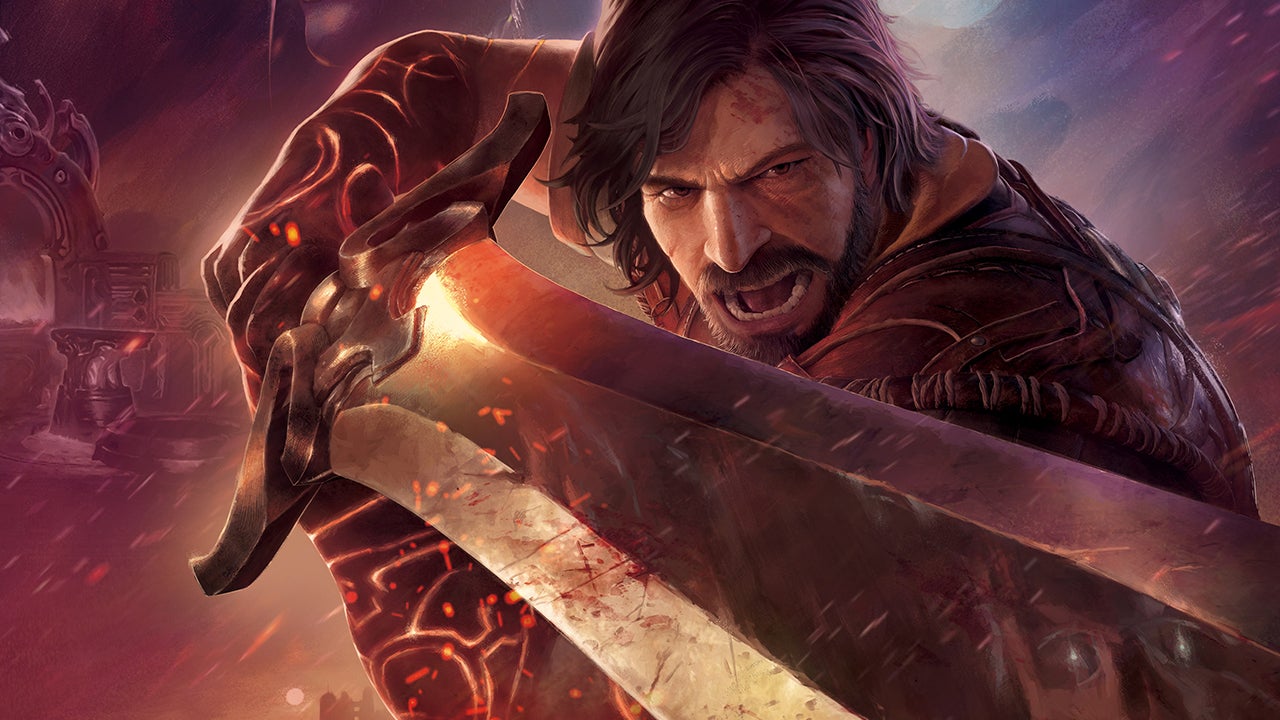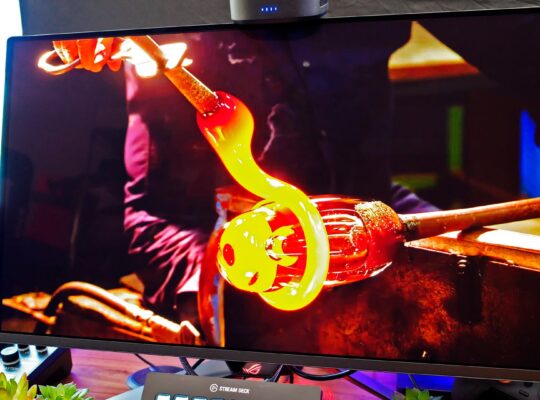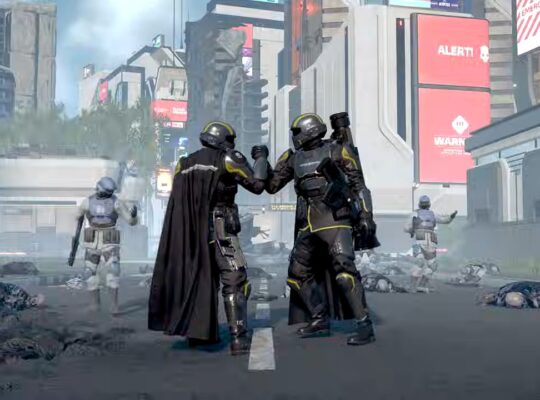
I always look forward to it when a studio steps out of its comfort zone to create something unexpected. Blades of Fire, a 3D action-RPG from developer MercurySteam, best known for the stellar Metroid Dread and its action-packed take on Castlevania during the PlayStation 3/Xbox 360 era, does just that. Combining its past successes to give you control of a blacksmith who crafts his own weapons of destruction seemed like a promising concept. Unfortunately, the superb crafting portions of this lengthy fantasy adventure are overshadowed by an uneven story and combat that lacks real depth.
You play as Aran, a commoner who gains access to a legendary forging hammer that sets him on a quest to stop the queen who is leading the kingdom into ruin. The three pillars of Blades of Fire are its satisfying but simple combat, enjoyable weapon crafting system, and emotionally unimpactful story. While very uneven, those were at least enough to keep me relatively entertained for the 55 hours it took me to reach the first round of credits. However, there’s only an unsatisfactory conclusion to find there, and it was the postgame scavenger hunt necessary to find the “true” ending that really drained what little enthusiasm I had left by the end.
Starting with the good, the crafting system stands as the tallest of the three pillars holding up Blades of Fire. Through the hammer Aran receives at the beginning of his journey, he can build the powerful weapons necessary to vanquish all that stand in his path. Initially you can only craft a singular weapon, a heavy polearm called the Hyssop that deals devastating strikes but uses a lot of stamina with each swing. However, after Aran vanquishes enough of a given enemy type, you will unlock a blueprint for the weapon they brandished against him. Dismantling 60 skeletons unlocks the claymore they would clumsily swing, while taking down just five spearmen from the queen’s transformed army grants access to a long spear that deals either piercing damage from afar or slashing damage in circular strikes. Finding and taking down each new enemy to expand your arsenal made for an enjoyable loop, and encouraged me to take down the stronger optional enemies whenever they appeared.
Interacting with a forger anvil, which function as both rest points and a fast travel system, can then transport you to a mystical forge that lets you create those weapons. When you do, you can adjust several aspects of them: For example, the Twin Mallets are limited to customizing the size and shape of the head and handle, where larger weapons like the Glaive also have options for adding a pommel. These choices modify that weapon in small but noticeable ways, tweaking weight, balance, and damage to your liking, as well as altering Aran’s maximum stamina and how much stamina it costs to dodge while using it.
The final part of forging a weapon is the actual forging itself. Crafting weapons in most games ends after selecting your materials, but Blades of Fire has you actually striking the heated metal to match the weapon’s shape. This system, while underexplained and confusing at first thanks to the lack of detailed tutorial, quickly became my favorite part of the journey. A weapon’s steel appears as bars similar to those on an audio visualizer, and some will shrink while others grow as you strike. The better you do, the longer a weapon will last before you need to sunset it to be recycled for parts or traded in to an ally for specific and often rarer materials. It took me half a dozen weapons before I figured out the proper technique for managing the strength, tilt, and width of each of my strikes, but once I did, I found myself confidently crafting weapons with the maximum rating every time.
For those who end up not enjoying the crafting, there is an option to skip the process after the first time, but the maximum number of times you can repair it will be limited to the best results you’ve created manually. This smartly expedited my return trips to the forge, as I’d often hold off replacing weapons until they were all beyond repair, turning what would be a lengthy process into a short trip that got me back in the action sooner. Blades of Fire even gives you the option to name your weapon before setting out, which I initially reserved primarily for punny names like Captain Falchion or Let me Axe You something – but eventually as I saw them reach their final forms with the best materials and enhancements, giving them names suitable of their legacy like Gae Bolg or Masamune.
Though there are 35 different weapons to wield and each vary between their speed, range, and other properties, combat unfortunately boils down to just eight attacks. These are performed by pressing the button on your controller that matches the part of an enemy you want to strike: So triangle/Y will strike at an enemy’s head, Circle/B will strike on the right, and so on. There are also charged attacks that deal higher damage and mutilate enemies if fatal, resulting in more gruesome deaths. It is disappointing, though, that mutilating an enemy’s head with either a blunt weapon or piercing weapon has the same animation, and seeing them fall off the same way got old after the first dozen times. There are also no combinations of attacks that offer any real benefit, so alternating left and right strikes is virtually the same as mindlessly spamming a single direction. If it wasn’t for the use of parries and perfect dodges that offer a small window of opportunity to retaliate safely, combat would have felt even more bland than it already does.
Choosing the directions of your attacks carefully becomes more necessary later on as enemies start to have different levels of resistance on each body part, and some like elementals can even move these weak points mid-combat. To its credit, Blades of Fire does have a large variety of enemies to fight – unfortunately, nearly every one of them is humanoid. That means that even though they all have their own unique quirks and attack patterns, I was rarely impressed by anything new that was thrown at me. Outside of bosses, which can be hulking behemoths that shake things up more substantially, one of the few interesting regular enemy types were the trolls: they have constant health regeneration and two health bars, requiring you to drain one bar and then mutilate a limb with a charged attack before you can attempt to finish them off. But a mechanic like that is the exception rather than the rule, and the predictability of every enemy’s clearly telegraphed attacks meant fights often just came down to my parry timing.
If you do fall in combat, the powers of the legendary hammer mean Aran doesn’t stay dead for long. However, his temporary deaths come with the penalty of dropping your equipped weapon at that location, similar to how you drop souls, blood echoes, and other currencies in games like Dark Souls or Bloodborne. Thankfully, Blades of Fire is much more forgiving, as any weapon dropped in a location turns to stone and remains in the world permanently until Aran retrieves it. This was a welcome change to the formula as the potential of permanently losing a weapon you’ve invested heavily into after consecutive deaths would have been extremely frustrating.
Last and certainly least, the most disappointing pillar of Blades of Fire is its story, characters, and world exploration. Aran’s quest to stop the queen does keep a decent pace, but it never surprised or wowed me and many moments that seemed like they should be impactful are hindered by an uneven delivery. At one point after killing a major boss, he simply fell to his knee and sat there until I struck him once more – it felt like it was set up for more, but there was no dialogue and no flair. Just this previously important character falling to the ground in anticlimatic fashion. Blades of Fire also has one of the most disappointing endings I’ve seen in a while, rolling credits with little resolution and then immediately sending you off on a scavenger hunt that is too long for its own good if you want to find out what’s actually going on.
Characters are generally one-note stereotypes, and often have dialogue that further enforces their simplistic nature. Aran regularly remarks that he’s not smart enough to solve the puzzles without the aid of Abdos, a young scribe who accompanies him on the journey, though Abdos doesn’t offer much advice outside of stating the obvious. Abdos is the brains to Aran’s brawn, deciphering codices you find, reading ancient languages to reveal paths or secrets, and magically sealing coffins during fights occasionally. Abdos also makes regular remarks about Aran’s size when climbing ladders, which ends up feeling like an out of place attempt at humor as Aran rarely responds or finds opportunities to tease back. They are written as if they’ve known each other for a long time despite meeting for the first time in the opening hours, which makes moments like these unearned and shoehorned in.
Rounding out the cast are Glinda the Master Forger, a cranky witch of the woods type that lives in a house on top of a flying beetle, and Arwen, an impatient and hardheaded young girl that is only involved in the final dozen hours and yet conveniently turns out to be super important. As time went on, the uncanny parallels between these characters and those in God of War and God of War Ragnarok became more and more distracting. Aran is just a less wise and somehow less charismatic Kratos, Abdos deciphers ancient languages and takes note of enemies and other elements of the world similar to Atreus, Glinda fills in the role of Freya, and Arwen is essentially a less prominent Angrboða. You even fight a giant snake at one point, and explore places that strongly resemble areas like the temple resting above the Lake of Nine. Different games using similar character archetypes or tropes isn’t anything new or wrong on its own, but it does start to feel derivative to a fault here – especially when Blades of Fire doesn’t come off so hot in such a direct comparison.
That’s not the only way it’s put in a bad light, as a lackluster map system often makes exploring for secrets very cumbersome and confusing. There are a ton of little hidden paths to find that lead to cool optional collectibles like shrines for upgrading your weapon customization options, chests with items that increase your healing flasks, gems to up your maximum health or stamina, and different dyes to customize Aran’s outfits. But many locations have multiple levels of elevation, and apart from staring at the one-dimensional map while hoping that you are reading it correctly, you don’t really have a way of knowing which level you are on until you either reach the correct destination or the wrong one. You can leave markers on the map that create a streak of color in the world as guidepoints, which at least help by adding distance and elevation cues to the compass at the top of the screen, but that’s only a half measure.











